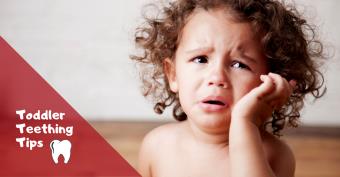Toddler Teething Tips
posted : 20/Mar/2019

Many infants and toddlers don’t display any sign of pain when they’re teething, but it can be a very different story when those 2-year old molars come through. These are the last of the baby teeth to come through and the most uncomfortable. The exact timing of the second molar eruptions can vary, but typically the top row will start to come in between 25 and 33 months, and 23 to 31 months on the bottom.
The most noticeable sign of this teething stage is that there is a shift in your toddler’s behaviour. Some parents would go as far as to say that their child has become quite the little monster. They won’t eat, they’re cranky, unusually irritable and they will chew on whatever they can get their tiny little fingers on.
Other symptoms that your toddler is teething can include;
- Broken sleep
- Restlessness
- Refusal to eat
- Excess drooling
- Spiked temperature
- Rubbing and pulling at ears
- Vomiting and Diarrhoea
It’s normal for your child to experience a level of discomfort, but the more severe symptoms should not be ignored. A watchful eye is recommended and a visit to the doctor may be required to rule out any other health concerns and to give you peace of mind.
Tips for relieving toddler gums during teething;
Chilled, Cold Items:
Chilling familiar items and foods such as their dummy or fruits and vegetables for them to gnaw on will help soothe the gums.
Teething Toys and Objects:
Teething toys are safe and designed with this specific development stage in mind. It will help prevent them from chewing on objects that they shouldn’t be putting in their mouths.
Attention and Distraction:
One-on-one playtime with your little one’s favourite toys or a splash around in nice warm bath is a good distraction. Also, staying on top of that dribble and keeping their face dry will help prevent skin irritation which will only add to the discomfort.
Patience:
This tip is for the parents. This stage of teething is undoubtedly the hardest for both children and parents. Be patient, it’s the time you will need to deal with teething and the associated behaviours.
Once your child has all of their little chompers, it is especially important to teach them how to care for their teeth and implement a positive, regular toothbrushing routine.
Library Home